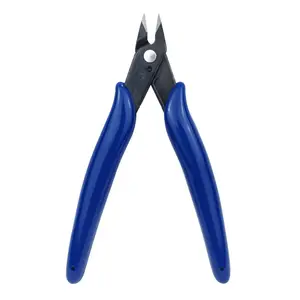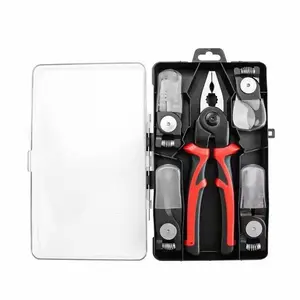

Electrical Wire Cable Cutters Cutting Side Snips Flush Pliers Nipper Mini Diagonal electronic cutting pliers

Diagonal Pliers Electrical Wire Cable Cutters Cutting Side Snips Flush Pliers 5" 130mm Nipper Hand Tools





















In the world of electrical work, the importance of wire cable cutters cannot be overstated. These tools, with their various types and features, are crucial for ensuring clean cuts and strong potential connections. However, the selection of the right tool can be a daunting task, given the multitude of options available. This comprehensive guide aims to demystify the process of choosing the right wire cable cutter. It delves into the anatomy of these tools, the different types available, and the factors to consider when making a selection. From understanding the significance of blade material and handle design to assessing wire type and size, this guide covers it all.
Wire and cable cutters are essential tools for ensuring clean cuts and strong potential connections in electrical work. They are implemented in various settings to prevent unintentional damage to wires and cables. The selection of the correct tool is crucial, and there are multiple types available, including ratcheting cutters. These tools are designed to work with different wire or cable gauges. Some of these tools are multipurpose, adding to their utility.
Wire cable cutters are a specific type of cutter, commonly used in electrical applications. They are typically insulated to prevent electrical shocks. It's crucial not to mistake the plastic or rubber coating on the levers of a non-insulated cable cutter for being electrical insulation. Another type is hydraulic cable cutters, used on various conductors, wire ropes, and even solid bars. They feature a guillotine-style head shear to minimize jams and are mainly used in the power utility and electrical industry for chopping copper or aluminium power cables and overhead conductors.
The anatomy of a wire cable cutter involves several key components. The 'Moving Blade Set' and 'Fixed Blade Set' are integral parts of the cutter, responsible for the cutting action. These blades can be found in various models. The 'Handle Set', available in plastic or fixed versions, provides the leverage needed for cutting. Other parts include the 'Replacement Head' for bolt cutters of varying sizes, 'Ratchet Pawl Set', 'Ratchet Release Plate Set', and 'Replacement Springs'. These components collectively ensure the efficient functioning of the wire cable cutter.
One standout product in our catalog features hardened steel blades, a material known for its durability and strength. This makes it capable of cutting through steel cables up to 12 mm in diameter, high tensile steel strands up to 8 mm thick, and even extra tough wire ropes up to 5 mm. The cutter is also effective for cutting electric cables of copper, aluminum, or steel-cored aluminum up to 12 mm. The quality of the blade material ensures optimum cutting yield, satisfying a wide range of industrial requirements.
A wire cutter's handle design significantly impacts its ergonomics. Long handle versions are designed to transfer force from the operator to the point of operation efficiently. The longer handle allows all four fingers to spread the cutting force, reducing strain on the hand. Shorter handles, in contrast, can compress nerves and tendons, reducing blood flow. Our wire cutters feature a unique double-sheathed, ESD safe, cushioned grip, distributing the cutting pressure more effectively.
One of our versatile tools is capable of cutting a variety of materials and wire sizes. It can cut soft wire rope up to 7mm, hard wire rope up to 5mm, and spring wire cable up to 4mm. It can also handle very hard steel and flex up to 3mm, electrical cable (copper, aluminum, or steel covered aluminum) up to 7mm, aluminum or copper rods up to 5mm, iron rods up to 4mm, and tempered steel spring up to 2.5mm. This range of cutting capabilities indicates a robust size and weight, suitable for diverse cutting needs.
Choosing the right wire cutter involves considering several factors. The cutting capacity indicates the size of wire it can cut, rated by wire gauge or cable diameter. The blade material is crucial as it determines the types of metals it can cut. For instance, many cutters can only cut aluminum and copper, common in electrical cables. If you need to cut steel cable, ensure your cutter is rated for steel. The handle length affects the leverage and force you can apply. Lastly, consider insulation. Insulated cutters can be used on live wires, unlike non-insulated ones.
Choosing the right wire cable cutter involves assessing the wire type and size. The wire size includes two aspects: thickness (gauge) and length. The gauge is determined by the carrying capacity and the amount of current the wire needs to conduct, measured in amperage or amps. The length of the wire can impact the gauge needed, as longer wires can lose more voltage through resistance. This can be counteracted by increasing the wire gauge, thus increasing the amperage capacity. Also, the type of wire, whether copper or aluminum, can influence the choice of cutter.
The frequency of use is another important factor to consider when choosing a wire cable cutter. If you're a professional who uses the tool daily, you might want to invest in a high-quality, durable cutter. However, if you only need it for occasional use, a more affordable option might suffice.
One of our ratcheting cable cutters is an excellent tool for service Electricians who seldom deal with large diameter cable. It's an option for commercial work where it’s not economical to spend many hundreds or even thousands on a power cutter. It’s also a bit smaller and less expensive than other versions. Blade replaceability makes this tool an even better deal. You might find it a little difficult to operate the quick release in a tight spot, but that’s rarely a concern. It makes smooth, easy cuts and doesn’t distort the cable.
When using cutting tools like wire cable cutters, safety should be a top priority. These tools are designed to cut various materials, including wires and cables. However, it's crucial to know some general safety tips to avoid accidents. For instance, always ensure that the cutter is suitable for the material you're cutting. Using the wrong cutter can lead to tool damage or personal injury. For more safety tips, refer to general hand tool operation guidelines.
Cable cutters require routine maintenance for longevity. After use, especially outdoors, they should be cleaned to remove dust and other substances. If stored for a long time, a dry rag can be used for cleaning. It's crucial not to disassemble them or knock them, as this may affect the internal structure. If glue gets on the cutter, it can be removed using common lotions or oils, then cutting paper until the glue is transferred to the paper. Proper care can increase the life of the cable cutter.
Choosing the right wire cable cutter is a critical decision that can significantly impact the quality of your electrical work. It involves considering various factors such as the cutting capacity, blade material, handle length, and insulation. It's also essential to assess the wire type and size, frequency of use, and balance between cost and quality. Safety precautions and regular maintenance are also crucial for safe operation and longevity of the tool. With the comprehensive information provided in this guide, you are now equipped to make an informed decision when selecting a wire cable cutter that best suits your needs.